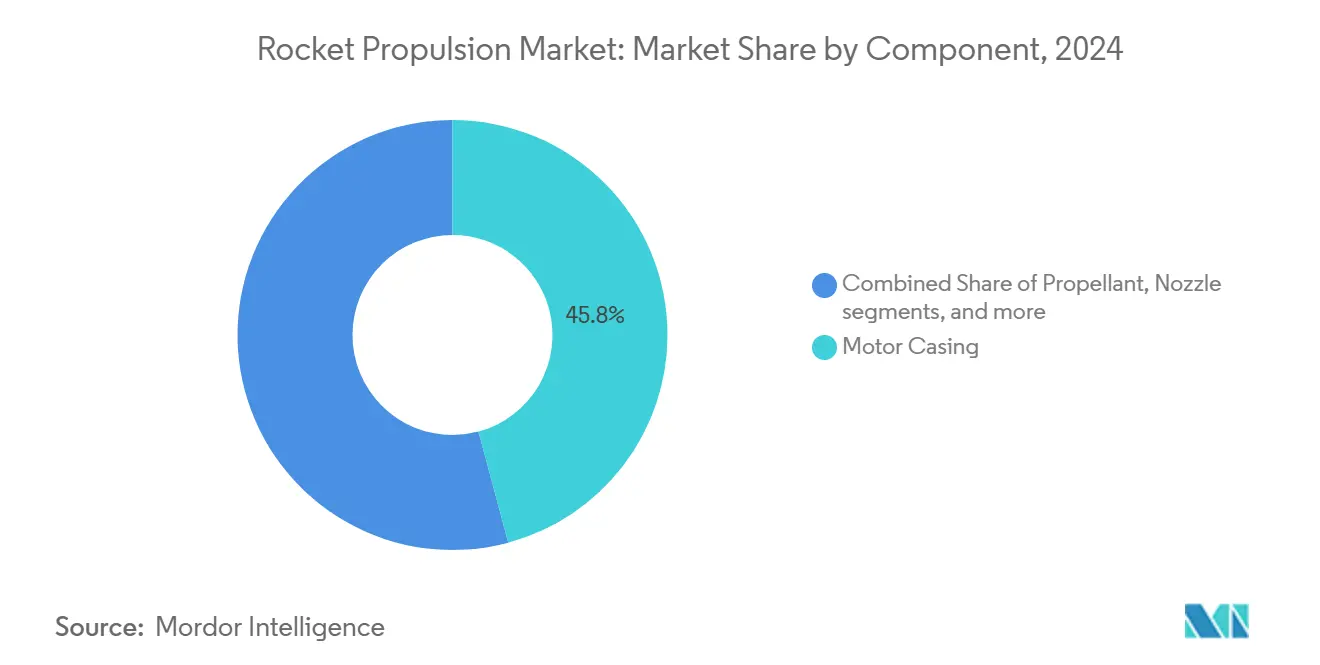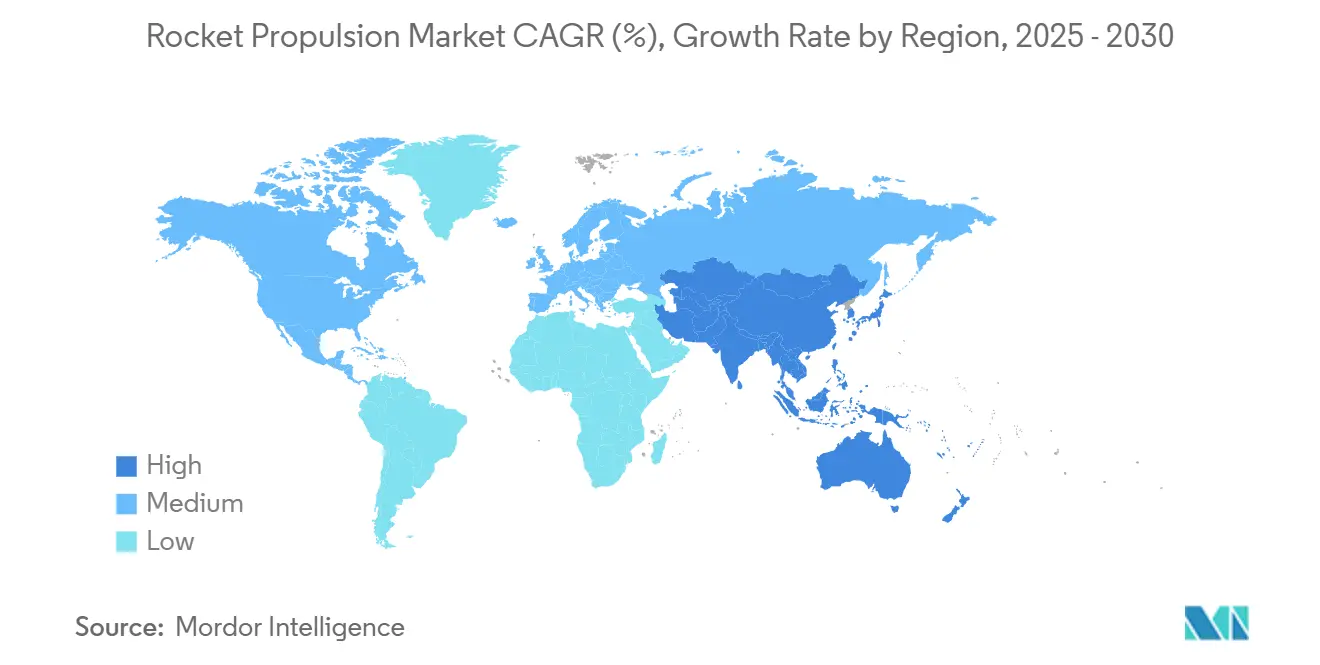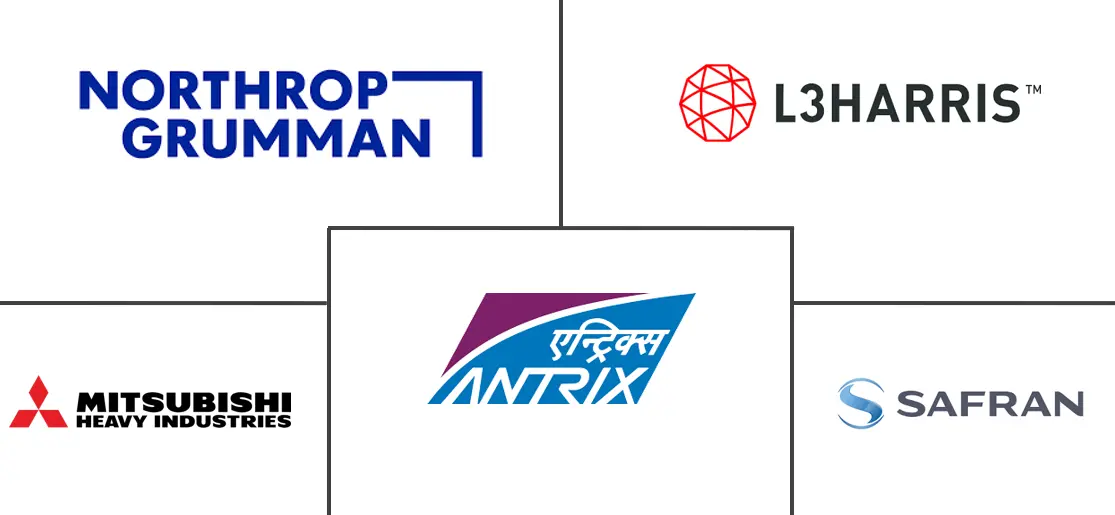Rocket Propulsion Market Size and Share

Rocket Propulsion Market Analysis by Mordor Intelligence
The rocket propulsion market size reached USD 6.99 billion in 2025 and is forecasted to climb to USD 9.84 billion by 2030, reflecting a 7.06% CAGR. Cost savings from reusable launch systems, the cadence required for mega-constellation roll-outs, and stepped-up defense spending collectively reshape demand and supply priorities. Liquid engines retain primacy because their higher specific impulse and throttling precision enable accurate orbital insertions. Yet, hybrid solutions are gaining traction as manufacturers seek lower-cost blends of liquid and solid technologies. North America currently dominates the volume, but the Asia-Pacific region shows the steepest trajectory as China and India expand their launch infrastructure. Across the ecosystem, additive manufacturing cuts component counts by up to 98%, redirecting competitive advantage toward vertically integrated producers with in-house printers.
Key Report Takeaways
- By propulsion type, liquid systems held 63.85% of the rocket propulsion market share in 2024, while hybrid systems are set to expand at a 9.27% CAGR to 2030.
- By end user, civil and commercial operators commanded 59.49% of the rocket propulsion market size in 2024, whereas military and government demand is projected to advance at an 8.10% CAGR through 2030.
- By component, motor casings led with a 45.82% revenue share in 2024; propellants are growing at the fastest rate of 7.94% CAGR, thanks to the adoption of green fuels.
- By type, rocket motors accounted for 59.37% of the rocket propulsion market size in 2024, while rocket engines are projected to register an 8.27% CAGR between 2025 and 2030.
- By geography, North America captured 38.96% of the rocket propulsion market share in 2024; Asia-Pacific is forecasted to post an 8.33% CAGR through 2030.
Global Rocket Propulsion Market Trends and Insights
Drivers Impact Analysis
| Driver | (%) Impact on CAGR Forecast | Geographic Relevance | Impact Timeline |
|---|---|---|---|
| Reusable launch vehicle economics | +1.80% | Global; early gains in North America and Europe | Medium term (2-4 years) |
| Rapid mini-sat and mega-constellation deployment | +1.50% | Global; concentrated in North America and Asia-Pacific | Short term (≤ 2 years) |
| Government deep-space and lunar-mission funding spike | +1.20% | North America, Europe and Asia-Pacific | Long term (≥ 4 years) |
| Hypersonic weapons propulsion race | +1.00% | Global focus on North America, Europe and Asia-Pacific | Medium term (2-4 years) |
| Additive manufacturing cost breakthroughs | +0.90% | Global; early adoption in North America and Europe | Short term (≤ 2 years) |
| Methalox and green-propellant adoption push | +0.70% | Global; regulatory influence in Europe and North America | Long term (≥ 4 years) |
| Source: Mordor Intelligence | |||
Reusable Launch Vehicle Economics
Successful booster recovery programs, such as Falcon 9, have already cut launch costs by more than 50% and shifted propulsion priorities toward rapid refurbishment rather than single-use, peak performance.[1]Sandra Erwin, “Lockheed Martin taps General Dynamics for solid rocket motor manufacturing,” SpaceNews, spacenews.com Engines now require robust turbopumps, advanced chamber cooling, and built-in health-monitoring sensors, allowing turn-time between flights to drop from months to days. Manufacturers respond with modular subsystems that technicians can swap on the pad, a design philosophy spilling over to satellite propulsion, where constellation operators benefit from lower deployment budgets. The economic ripple encourages smaller launch providers to enter the market with reusable micro-launchers. Component suppliers consequently invest in high-cycle fatigue testing and automated non-destructive inspection lines to validate re-flown hardware within compressed schedules.
Rapid Mini-sat and Mega-constellation Deployment
Constellation plans involving thousands of spacecraft force propulsion factories to scale well beyond historic lot sizes. High-rate upper-stage engine production supports steady weekly launch rhythms, while electric thrusters for in-orbit station-keeping move toward automotive-style production cells. Standardized engine families reduce qualification burdens and enable multi-launch contracts that secure bulk pricing. Satellite makers simultaneously request propellant combinations with fewer ground-handling hazards to streamline integration flows. The boom fuels secondary demand for test stands, cryogenic storage tanks, and avionics, creating an expansive industrial loop that maintains high capacity utilization across the rocket propulsion market.
Government Deep-space and Lunar-mission Funding Spike
NASA’s Artemis and nuclear-thermal initiatives have reopened budgets for ultra-high specific-impulse technologies that promise trip-time reductions to Mars. L3Harris is ramping up RS-25 production with additively manufactured injectors, while Northrop Grumman tests upgraded solid boosters that can produce over 4 million lbs of thrust for crewed flights. International partners in Europe and Asia collaborate on lunar logistics modules, stimulating work on storable green bipropellants for surface ascent vehicles. Program timelines, extending well beyond 2035, create sustained R&D funding streams that small propulsion startups can tap via subcontracting and component licensing. The long-range nature of deep-space missions also encourages standardization of interfaces to simplify cross-agency hardware sharing.
Hypersonic-Weapons Propulsion Race
Defense ministries have accelerated spending on scramjet, boost-glide, and dual-mode rocket engines to close perceived capability gaps. Thermal-protection and fuel-injection breakthroughs achieved for missiles quickly find second lives in upper-stage kick motors operating in similar Mach regimes. Supply-chain security drives fresh investment in domestic ammonium perchlorate and advanced composite casings, reducing reliance on foreign vendors. Export-control constraints elevate the strategic value of in-house test ranges and classified design toolchains, which only a handful of companies can afford, thus reinforcing consolidation trends. The cross-pollination of military and commercial technologies is driving the rocket propulsion market toward materials that can withstand higher combustion temperatures without compromising reusability.
Restraints Impact Analysis
| Restraint | (%) Impact on CAGR Forecast | Geographic Relevance | Impact Timeline |
|---|---|---|---|
| Cryogenic-supply-chain bottlenecks | −0.8% | Global; acute in North America and Europe | Short term (≤ 2 years) |
| Stringent export-control regimes (ITAR, MTCR) | −0.6% | Global; primary impact on international trade flows | Medium term (2-4 years) |
| Solid propellant raw-material shortages | −0.5% | North America and Europe; ripple effects worldwide | Short term (≤ 2 years) |
| Infrastructure limitations in emerging space nations | −0.4% | Latin America and Middle East; parts of Asia-Pacific | Medium term (2-4 years) |
| Source: Mordor Intelligence | |||
Cryogenic Supply Chain Bottlenecks
Liquid-hydrogen (LH2) and liquid-oxygen (LOX) production have not kept pace with launch tempo, causing scheduling conflicts at shared pads and driving demand for costly mobile storage farms.[2]U.S. Air Force Research Laboratory, “AFRL researchers pave the way to lighter, faster additively manufactured rocket engines,” afrl.af.mil Smaller launch companies feel the pinch most acutely because existing suppliers prioritize high-volume anchor customers. Infrastructure expansion often faces lengthy permitting timelines and scrutiny from local communities. Boil-off losses translate to stranded costs and emissions that conflict with emerging environmental regulations, prompting some operators to consider methane or green monopropellants. Until production capacity catches up, propulsion scheduling flexibility will continue to be a competitive differentiator.
Stringent Export-control Regimes (ITAR, MTCR)
Complex approval cycles for dual-use propulsion hardware slow cross-border sales and joint ventures, particularly for new entrants without established compliance teams. Partner nations often respond by funding indigenous programs, thereby fragmenting global demand and increasing overall development costs. Documented supply routes, encryption standards, and on-site audits add overhead that can erode the cost gains from additive manufacturing. Therefore, companies with diversified domestic portfolios gain a relative advantage because they can amortize compliance expenses over larger volumes. Policymakers continue to debate carve-outs for purely commercial engines, yet security concerns tied to hypersonics keep restrictions tight.
Segment Analysis
By Propulsion Type: Liquid Systems Drive Performance Evolution
Liquid engines captured 63.85% of the rocket propulsion market share in 2024 and are expected to hold leadership as the segment’s inherent throttling accuracy remains indispensable for precise orbital insertions.[3]L3Harris Technologies, “Delivers New Generation of RL10 Rocket Engines,” l3harris.com Innovations such as 3D-printed copper chambers reduce part counts by 98%, significantly slashing build times and costs. Hybrid propulsion, however, is projected to grow at a 9.27% CAGR, aligning with new launchers that blend solid fuel grains and liquid oxidizers to balance simplicity with restart capability. Solid motors remain relevant for tactical missiles and long-term storage needs, where shelf-life reliability takes precedence over specific impulse.
The rocket propulsion market continually rebalances as methane-oxygen combinations gain favor for their lower toxicity and ease of reloading on reusable stages. Hybrid engines utilize advanced swirl injectors to enhance combustion efficiency, while solid motors benefit from high-energy propellant chemistries that extend range without increasing airframe size. Liquid systems also utilize closed-cycle turbopumps fabricated through additive manufacturing, which reduces mass and improves thrust-to-weight ratios. Regulatory pushes toward cleaner emissions will further elevate green bipropellants, giving liquid suppliers a head start in certification pathways.

Note: Segment shares of all individual segments available upon report purchase
By End User: Military Demand Accelerates Defense Spending
Civil and commercial customers maintained 59.49% of the rocket propulsion market size in 2024, yet military and government programs exhibit an 8.1% CAGR that now outpaces the broader market. Hypersonic glide vehicles, missile defense interceptors, and responsive-space initiatives consume large numbers of solid motors and upper-stage engines. Defense budgets favor contractors that can stand up surge lines during crises, prompting investments in modular plants across Virginia, Arkansas, and Alabama.
Commercial operators, meanwhile, focus on cost per kilogram and launch cadence. Their procurement policies reward engine families offering commonality across multiple vehicle classes. Government agencies remain pivotal to technology breakthroughs, underwriting nuclear-electric and nuclear-thermal demonstrations that will ultimately benefit commercial deep-space logistics. As defense customers prioritize robustness against peer threats, propulsion makers must partition product lines to meet divergent durability versus affordability benchmarks within the rocket propulsion market.
By Component: Propellant Innovation Drives Growth
Motor casings accounted for 45.82% of revenue in 2024, primarily due to the widespread adoption of carbon-fiber composites, which reduce dry mass without compromising tensile strength.[4]3D Systems, “Propulsion & Space Launch,” 3dsystems.com Propellants, however, are on track for a 7.94% CAGR through 2030 as ionic liquids, high-test peroxide, and methalox blends gain regulatory approvals. Additive manufacturing enables nozzles with intricate regenerative-cooling channels, enhancing engine life in reusable architectures.
Fuel-system designers are increasingly adopting modular tank assemblies to accommodate diverse launch-vehicle diameters, thereby simplifying final assembly logistics. Integrated avionics sensor suites monitor propellant conditions in real time, feeding health-management software that schedules predictive maintenance. The shift toward green propellants also stimulates demand for new catalyst beds and elastomer seals, widening the supplier base within the rocket propulsion market.

Note: Segment shares of all individual segments available upon report purchase
By Type: Rocket Engines Lead Technology Innovation
Rocket motors held 59.37% of the rocket propulsion market in 2024 by providing tried-and-true thrust for missiles and disposable launch stages. Engines, notably liquid and hybrid variants, are expected to post an 8.27% CAGR as reusable-stage adoption increases. High-cycle durability drives demand for super-alloy turbomachinery, as well as dual-bell or aerospike nozzle geometries, which are made viable by powder-bed fusion printers.
On the motor side, new propellant grains with metallized binders boost specific impulse while maintaining production simplicity. Engine suppliers refine thrust-vector-control actuators to support rapid platform maneuvers, a key feature for hypersonic vehicles. Over the forecast window, the once-rigid boundary between motors and engines blurs further, courtesy of hybrid architectures integrating liquid oxidizer tanks within traditional motor casings.
Geography Analysis
North America commands the largest slice of revenue, driven by mature manufacturing clusters and substantial US Department of Defense (DoD) outlays. L3Harris’s new facilities aim to produce 25,000 solid rocket motors annually by 2029, ensuring sufficient inventory for both strategic missiles and interceptors. SpaceX’s vertically integrated engine lines in California and Texas exemplify cost efficiencies that ripple through the launch services value chain. Export-control regimes concentrate advanced know-how inside domestic borders, sustaining high utilization rates for US test stands and cryogenic suppliers.
The Asia-Pacific region exhibits the fastest growth, underpinned by China’s state-backed launch manifest and India’s deregulated space economy, which opens orbital slots to private operators. Indigenous propulsion start-ups benefit from government procurement quotas that favor homegrown technology. Australia has begun seeding composite-motor research centers, and Japan directs R&D subsidies toward high-strength ceramic matrix nozzles. The regional race for capacity also triggers cooperative agreements on liquid-oxygen plants and test ranges, distributing investment across multiple nations.
Europe maintains a diversified supplier base that prioritizes environmental stewardship. ArianeGroup’s shift toward recoverable stages dovetails with EU climate directives, positioning methalox and green monopropellants as differentiators. National agencies in France and Germany co-fund additive-manufacturing centers to strengthen autonomy from non-EU metals. Smaller European states participate via subsystem specialization, supplying valves and sensors for large engine families. Although launch volume remains modest compared to North America, the continent’s emphasis on advanced materials and stringent certification standards allows premium pricing.

Competitive Landscape
The rocket propulsion market is consolidating around players that combine government contracts with commercial backlogs and possess in-house additive manufacturing capacity. L3Harris finalized its USD 4.7 billion takeover of Aerojet Rocketdyne, bringing solid motor and liquid engine lines under one roof. Northrop Grumman, meanwhile, is scaling to produce 50 million lb of propellant annually by 2028, wielding economies of scale that few peers can match.
Disruptors such as Beehive Industries prove competitive on cost by 3D-printing engines with 90% fewer parts, trimming labor and inspection steps. Anduril entered the fray with a new Mississippi solid-motor line, signaling that venture-backed entrants can carve share when they address defense bottlenecks. Traditional engine OEMs respond by layering digital twins over production cells to predict build anomalies before they occur, thus safeguarding reputations for reliability.
Strategic partnerships now revolve less around performance R&D and more around assured supply. Launch providers sign multi-year block-buy agreements covering everything from propellants to flight computers, buffering against material shortages. Intellectual property protection remains a sticking point in cross-border ventures, prompting firms to establish regional subsidiaries that meet local security clearance requirements. As additive manufacturing gradually democratizes engine fabrication, the competitive edge shifts toward proprietary alloys, automated post-processing, and the depth of qualification data.
Rocket Propulsion Industry Leaders
-
L3Harris Technologies, Inc.
-
Northrop Grumman Corporation
-
Safran SA
-
Antrix Corporation Limited
-
Mitsubishi Heavy Industries, Ltd.
- *Disclaimer: Major Players sorted in no particular order

Recent Industry Developments
- August 2025: Anduril opened a solid rocket motor plant in Mississippi, becoming the third major US supplier and expanding domestic capacity for defense programs.
- April 2024: L3Harris unveiled the In-Space Engine family of 3D-printed bipropellant thrusters ranging from 5–900 lbs thrust.
Global Rocket Propulsion Market Report Scope
Rocket propulsion is a critical sub-system of a rocket that propels itself from the ground into the atmosphere. This study delves into the various rocket propulsion systems crucial for space launch vehicles.
The rocket propulsion systems market is segmented by type, end user, and geography. Based on type, the market is segmented into solid, liquid, and hybrid. By end user, the market is segmented into civil and commercial, and military. The report also covers the market sizes and forecasts for the rocket propulsion systems market across different regions. For each segment, the market size is provided in terms of value (USD).
| Solid |
| Liquid |
| Hybrid |
| Civil and Commercial |
| Military and Government |
| Motor Casing |
| Nozzle |
| Propellant |
| Other Components |
| Rocket Motor |
| Rocket Engine |
| North America | United States | |
| Canada | ||
| Mexico | ||
| Europe | United Kingdom | |
| France | ||
| Germany | ||
| Russia | ||
| Rest of Europe | ||
| Asia-Pacific | China | |
| India | ||
| Japan | ||
| South Korea | ||
| Rest of Asia-Pacific | ||
| South America | Brazil | |
| Rest of South America | ||
| Middle East and Africa | Middle East | United Arab Emirates |
| Saudi Arabia | ||
| Rest of Middle East | ||
| Africa | South Africa | |
| Rest of Africa | ||
| By Propulsion Type | Solid | ||
| Liquid | |||
| Hybrid | |||
| By End User | Civil and Commercial | ||
| Military and Government | |||
| By Component | Motor Casing | ||
| Nozzle | |||
| Propellant | |||
| Other Components | |||
| By Type | Rocket Motor | ||
| Rocket Engine | |||
| By Geography | North America | United States | |
| Canada | |||
| Mexico | |||
| Europe | United Kingdom | ||
| France | |||
| Germany | |||
| Russia | |||
| Rest of Europe | |||
| Asia-Pacific | China | ||
| India | |||
| Japan | |||
| South Korea | |||
| Rest of Asia-Pacific | |||
| South America | Brazil | ||
| Rest of South America | |||
| Middle East and Africa | Middle East | United Arab Emirates | |
| Saudi Arabia | |||
| Rest of Middle East | |||
| Africa | South Africa | ||
| Rest of Africa | |||
Key Questions Answered in the Report
What is the current value of the rocket propulsion market?
The rocket propulsion market size stands at USD 6.99 billion in 2025 and is projected to reach USD 9.84 billion by 2030.
Which propulsion type dominates revenue?
Liquid engines lead with 63.85% share in 2024, owing to their high specific impulse and throttling precision.
Which region is growing fastest?
Asia-Pacific is forecasted to expand at an 8.33% CAGR through 2030, driven by Chinese and Indian launch-rate increases.
How does additive manufacturing influence competition?
3D-printing cuts engine part counts up to 98%, lowering costs and favoring vertically integrated firms with in-house printers.
What is the key restraint limiting near-term growth?
Global shortages in cryogenic propellant production and storage infrastructure create scheduling bottlenecks for launch providers.
How will military demand shape future propulsion investment?
Hypersonic-weapons programs drive an 8.10% CAGR for military applications, spurring new solid-motor plants and high-temperature materials R&D.
Page last updated on:



